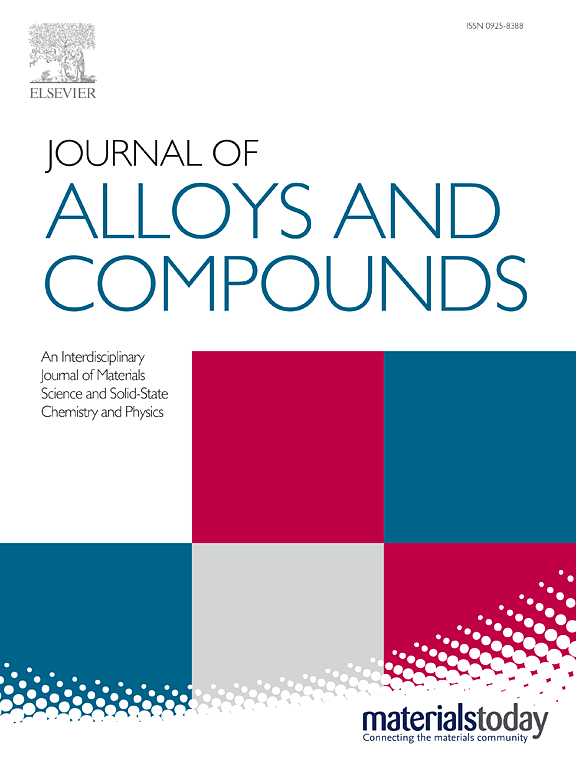超声频率对激光熔覆碳化铬增强镍基涂层组织和性能的影响
IF 5.8
2区 材料科学
Q2 CHEMISTRY, PHYSICAL
引用次数: 0
摘要
研究人员利用超声辅助激光熔覆技术,在H13热加工工具钢基体上制备了镍基碳化铬涂层。研究了超声频率对镍基碳化铬涂层组织、力学性能和磨损特性的影响。结果表明:超声处理后激光熔覆镍基碳化铬涂层的相组成没有变化;超声波干扰破坏了Marangoni流动,导致空化脱气,随后孔隙度降低。稀释率从11.2%增加到16.3%,表面平整度和缺陷抑制分别在34和36 kHz时达到最佳水平。显微观察,在26和28 kHz频率下,柱状晶粒细化到13~15μm;在32和34 kHz时,空化和声流协同作用,在顶部形成3~5μm的等轴晶粒;在36 kHz时,空化气泡半径与枝晶间距匹配最优,柱状晶细化至3.5μm,等轴晶细化至2.1μm,占总数的65%。在38khz以上频率处,高频衰减效应加剧,导致精细化效率下降。随着超声频率的增加,涂层的平均显微硬度从597.9 HV0.5增加到738.1 HV0.5。36 kHz超声波作用后,涂层晶粒细化,界面结合增强,空化冲击和声流作用减弱了马氏体流动和粘附作用,从而减少了孔隙和裂纹。磨痕由深而宽的犁痕转变为浅而窄的犁痕,深度从99.3μm减小到95.4μm,宽度从1570.2μm减小到1466.3μm。堆积、剥落现象基本消除。超声处理通过“碳化物细化-界面冶金转变-基体强化”三合一的机制,实现了从严重塑性变形到轻度犁化的转变,显著提高了涂层的耐磨性和稳定性。此外,超声波振动已被证明可以有效地减少熔覆层裂纹的形成,提高熔覆层质量,延长零件的使用寿命。本文章由计算机程序翻译,如有差异,请以英文原文为准。
Effect of ultrasonic frequency on the microstructure and properties of laser cladding chromium carbide reinforced nickel-based coatings
Using ultrasound-assisted laser cladding technology, researchers prepared nickel-based chromium carbide coatings on H13 hot-work tool steel substrates. The present study investigated the effects of ultrasound frequency on the microstructure, mechanical properties, and wear characteristics of nickel-based chromium carbide coatings. The results demonstrated that the phase composition of nickel-based chromium carbide coatings prepared by laser cladding after ultrasonic treatment remained unchanged. Ultrasonic interference disrupted the Marangoni flow, leading to cavitation degassing and a subsequent decrease in porosity. The dilution rate increased from 11.2% to 16.3%, with surface flatness and defect suppression attaining optimal levels at 34 and 36 kHz, respectively. Microscopically, at frequencies of 26 and 28 kHz, columnar grains were refined to 13~15μm; at 32 and 34 kHz, cavitation and acoustic flow synergized to form equiaxed grains of 3~5μm at the top; at 36 kHz, the cavitation bubble radius and dendrite spacing were optimally matched, with columnar crystals refined to 3.5μm and equiaxed crystals reaching 2.1μm, accounting for 65% of the total. The high-frequency attenuation effect intensifies at frequencies above 38 kHz, leading to a decline in refinement efficiency. The average microhardness of the coating increases with increasing ultrasonic frequency, from 597.9 HV0.5 to 738.1 HV0.5. Following the application of 36 kHz ultrasonic waves, the coating grains underwent refinement, the interface bonding experienced reinforcement, and the cavitation impact and acoustic flow effects diminished the martensitic flow and adhesion effects, thereby reducing pores and cracks. The grinding marks transformed deep and wide plow grooves to shallow and narrow plow marks, with the depth exhibiting a decrease from 99.3μm to 95.4μm and the width demonstrating a reduction from 1570.2μm to 1466.3μm. The phenomena of pile-up and peeling were almost eliminated. Ultrasonic processing achieves a transition from severe plastic deformation to mild plowing through a three-in-one mechanism of "carbide refinement-interface metallurgical transformation-matrix strengthening," which significantly enhances the wear resistance and stability of the coating. Furthermore, ultrasonic vibration has been demonstrated to effectively reduce the formation of cracks in the cladding layer, enhancing its quality and extending the service life of components.
求助全文
通过发布文献求助,成功后即可免费获取论文全文。
去求助
来源期刊

Journal of Alloys and Compounds
工程技术-材料科学:综合
CiteScore
11.10
自引率
14.50%
发文量
5146
审稿时长
67 days
期刊介绍:
The Journal of Alloys and Compounds is intended to serve as an international medium for the publication of work on solid materials comprising compounds as well as alloys. Its great strength lies in the diversity of discipline which it encompasses, drawing together results from materials science, solid-state chemistry and physics.
 求助内容:
求助内容: 应助结果提醒方式:
应助结果提醒方式:


